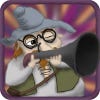
Featured Blog | This community-written post highlights the best of what the game industry has to offer. Read more like it on the Game Developer Blogs.
How We Create Lively Game Characters With Well Written Dialogue
Well written dialogue can make good games great. We at Halkologic Games have put a lot of effort on refining the way we write dialogue and want to share our best practices with you. Contains step by step instructions of our writing process with examples.

How We Create Lively Game Characters With Well Written Dialogue
(Warning: this blog post contains spoilers of Hannu the Hunter plot twists!)
Video games are better known for astonishing graphics than excellent writing. That’s understandable, since visual appearance is far easier to market than great dialogue or story. It’s not uncommon to see hollow conversations in games that leave the characters dull and grey, which is pity because good writing is not that time consuming or hard. It just has to be given the attention that it deserves.
At Halkologic Games we invest a lot of effort into making dialogues that are well written. Our recently released mobile game Hannu the Hunter has - to our delight - received a lot of praise of it’s entertaining dialogue from the players. That’s why I decided to write about our process of writing great game dialogue.

Writing Progresses in Phases
Let’s start with a confession: none of the writing methods we use are really our invention. We just apply the methods that novel writers use in their writing process. And why not? Great books have been written for hundreds of years. Why to reinvent the wheel?
Successful writing process usually requires a lot of preparation before actually starting to write the final text. Same applies to game dialogue too. When the background work is done well, the actual writing part becomes hugely easier and quality and speed are increased too.
So here we go, let’s start building foundations.
It’s good to start by drafting a one sentence summary of what is the story of your game. This forces you to think what is actually the main theme of your story. This step is also important because characters and story are tied together with symbiotic relationship - both lose value if the other is missing.
Example:
Hannu - an unemployed hunter - is hired by a village tormented by rabies bunnies and get’s pulled into a quest to settle a conflict of a witch and his ex-husband that threatens the entire kingdom.
Now that the fundamental story line of the game is defined, it’s time to expand the description. Write a longer and more detailed description of the story lenght of about one paragraph. This description could contain the setting or starting point of your story and all the key turning points with one (or two) sentence each.
Example:
A village hires an unemployed hunter - Hannu - to help with rabies bunnies that torment the village. It turns out that the menace is caused by Doris the Witch who is village chief Olaf’s ex-wife and is angry to him after finding out about Olaf having another woman. After being interrupted by Hannu, Doris leaves in anger and aims to cause more chaos. Olaf hires Hannu to stop the angry witch and Hannu follows her around the kingdom. At point Doris learns that Olaf’s other woman was her sister Helga and get’s even angrier. The sisters continue causing troubles together, but little later Helga gets imprisoned by the king for sending dragons to attack his keep and Doris flees. Hannu finds Doris, and it turns out that the king has captured the queen of dragons and Doris and Helga were only helping the dragons to free her. Hannu and Doris become allies and they free Helga from captivity. The king get’s angry and starts to chase them. The king has corrupted the dragon queen to obey him and sends her to destroy Hannu and others. Hannu defeats the dragon and the dragon queen is freed from the spell that controlled her. Doris is so grateful to Hannu for helping free her sister that she agree to forgive Olaf.
This description is aimed to you, not the players so it does not have to be well written or entertaining itself. The point is that the story is now documented and it’s time to get into the real business - writing the characters. In order to know how our characters speak, how they act and what they say, we have to first know who they are, what their motives are, and also what is their role in the story. That’s why the next step is to write so called character synopses of all the important characters. These are supposed to summarize the key features the characters.
Example:
Name: Doris the Witch
One sentence summary of the characters storyline: Doris gets angry after finding out that his ex-husband has another woman and starts to cause chaos in anger.
Motivation (abstract): Wants satisfaction after getting her feeling hurt
Goal (concrete): Wants to cause damage to satisfy her anger, and so revenge to her ex-husband Olaf.
Conflict (the obstacles): His rampage is interrupted by Hannu the Hunter and later by the king who captures her sister
Change (how is the character different after the story): desperation forces Doris to find humility from her heart after her sister is captured and later she submits to forgive to Olaf
The above synopsis format is quite compact and some may find it useful to write alot more. You can include things like history of the charater, descriptions of his/her personality etc. These are things that can be later used as source material when writing the actual dialogue.
At this point you may find out that there is flaws in your characters or story that needs to be fixed. For example if you can’t see why your character would do something that s/he is supposed to do according to the story, there is probably something that needs to be changed. Remember that writing is iterative process and you can go back to the previous steps and change the story and characters until you are satisfied with them.
At this point you may also start to feel that you know your characters. You can hear their voices in your head and can easily imagine how they would act in certain situations. Your characters are starting to have character. This is what this whole process is aiming to - vivifying the beings that interact in your game.
If you feel that your characters are now living beings in your imaginations that you can easily make to interact with each other, you may be ready to start writing the actual dialogue. But if you still feel a little unsure, try the practice below.
Make your characters to interact. Write scenes where the characters speak with each others. When you write, concentrate on things like, voice (does this sound like my character?), choice of words (is this the vocabulary that my character uses?), and status (what is the character’s status compared to the opponent? Is the character acting according the relative status?). When you do this kind of practices enough, the characters are going to vivify inevitably. You start unconsciously write dialogue that sounds like your characters, because you have image in your head what they are like. When you feel comfortable to start writing the actual game dialogue, you are ready.
Writing the Dialogue
As I said, if you’ve done the groundwork well, writing the dialogue should be easy. Still, I think some tips to the actual dialogue writing part are worth mentioning.
When you write a conversation (a piece of dialogue), think what is the purpose of the dialogue. Is it supposed to advance to story, deepen the characters, instruct the player or just be entertaining? Or all/some of them together? This way you know better what you are aiming for with this conversation.
What to do when you get stuck? Writing is creative work and sometimes it’s very hard to get started. Empty page is the writer’s worst enemy so if you can’t write anything proper, just write something. It doesn’t matter if it’s bad. You can always come back and change it later. When the words start to flow on paper, the inspiration will follow. Or not. And that’s ok too. Every day is not writing day and if it’s not working you can quit and try again some other day.
Don’t be perfectionist, but revise often. When the text is coming easily, just keep writing and worry about the quality later. Later (for example next day) revise what you’ve written and fix/modify what is needed. It’s a lot easier to see your mistakes when there is a break between writing and revising.
Final Words
There are many ways to write dialogue and this is what we have found effective to us. I hope it helps someone to write better games.
As I said earlier, we haven’t invented these methods our selves but simply use the methods that novel writers usually use. This writing process is largely inspired by the snowflake method. You can find a good article about it from here:
http://www.advancedfictionwriting.com/articles/snowflake-method/
If you wish to see what kind of dialogue our methods managed to create, you can find our free mobile game Hannu the Hunter from Google Play (iOS release coming soon) or read more about it from the game's website:
https://play.google.com/store/apps/details?id=com.Halkologic.HannuTheHunter
http://hannuthehunter.weebly.com/
Read more about:
Featured BlogsAbout the Author(s)
You May Also Like













